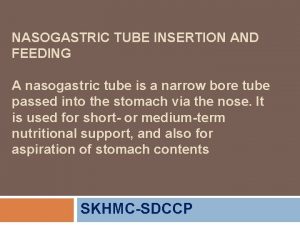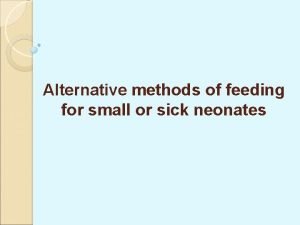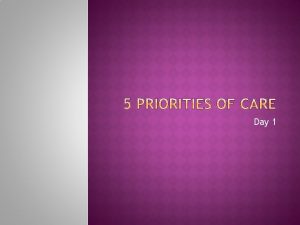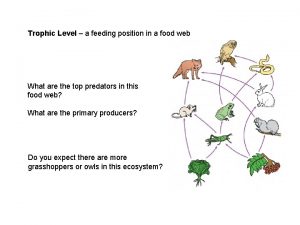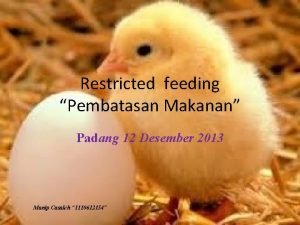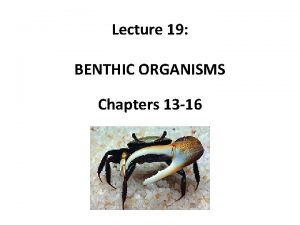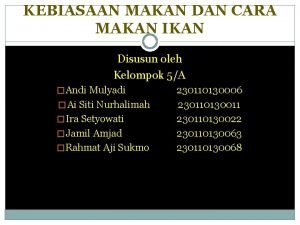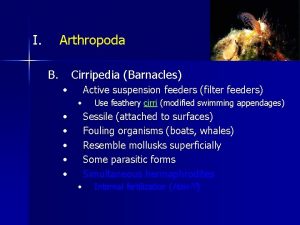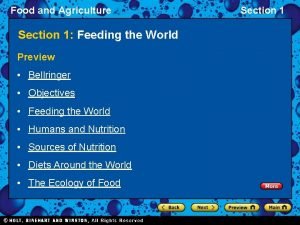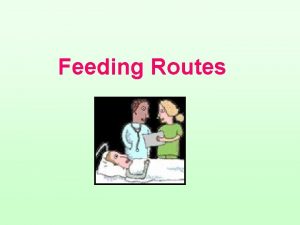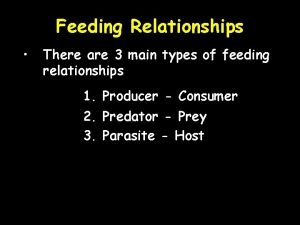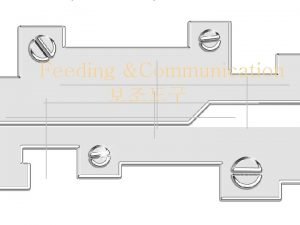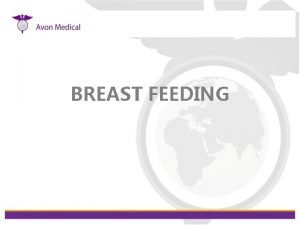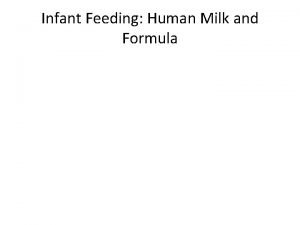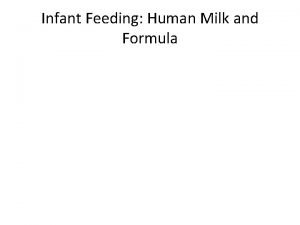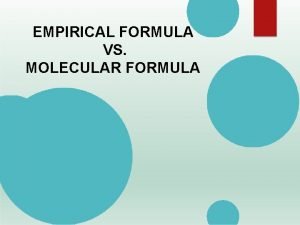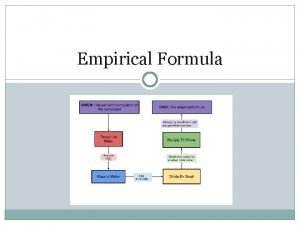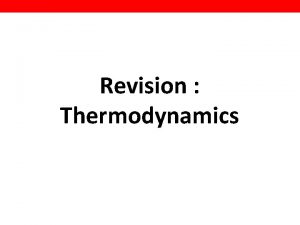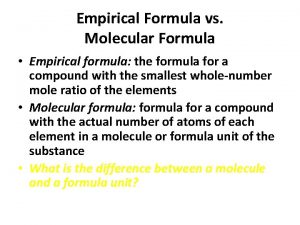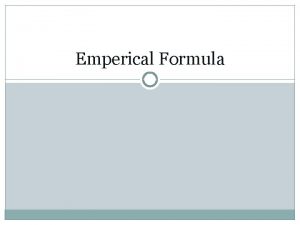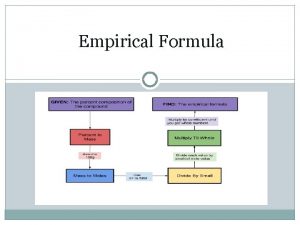Formula feeding Presentation rules Definition Formula feeding Feeding




















- Slides: 20


Formula feeding

Presentation rules

Definition: Formula feeding: Feeding an infant or toddler prepared formula instead of or in addition to breastfeeding. Formula feeding is indicated when the mother has an illness that could be passed on to the baby through breast milk or through the close physical proximity required for breastfeeding.

Procedure Steps 1 Wash hands 2 Wear the gloves 3 Prepare the equipment Rationale To reduces transmission of microorganisms before formula preparation To promote disinfection To perform procedure 4 Explain the procedure to To enhance understanding and cooperation the Mother of mother. During the procedure 1 Clean any surface To prevent transmission of microorganisms thoroughly where the feed to formula is prepared.

Procedure, cont. , Steps Rationale 2 Wash hands with soap and water To prevent infection transmission 3 Boil fresh tap water in a kettle. (it may be helpful to roll the Alternatively bottled water that is infant on the side to smooth the suitable for infants can be used for blanket behind the back then roll making up feeds and should be the infant into the back over boiled in the same way as tap smooth section of the blanket ) water. 4 Allow the boiled water to cool to no less than 70 o. C. This means in practice using water that has been left covered for less than 30 minutes after boiling. For sterilization

Procedure, cont. , Steps 5 6 Rationale Pour the amount of boiled To prepare accurate amount of water required into the feeding. sterilized bottle Add the exact amount of To prevent over Or under nourished formula as instructed on the of baby. label always using the scoop provided with the powered formula by the manufacturer. Don't add any extra powder than instructed as this could make the baby ill.

Procedure, cont. , Steps 7 8 9 10 Rationale Re-assemble the bottle To enhance good preparation of following manufacturer's formula. instruction. Shake the bottle well to mix the To avoid improper mix of powdered contents. milk. Cool quickly to feeding Temperature by holding under a running tap, or placing in a container of water. Check the temperature by shaking a few drops onto the inside of the wrist – it should feel lukewarm, not hot. To provide neutral milk temperature for feeding the baby. To prevent harming the baby.

Procedure, cont. , Steps Rationale Any feed that has been used To prevent contamination within 2 hours should be of feeding discarded. After procedure 11 1 Wash hand To prevent infection 2 Put the Infant in comfortable Position Record and report any abnormality To prevent discomfort and colic To promote follow up of baby condition 3

Nasogastric Tube Insertion

Introduction When baby is too sick for well-coordinated sucking, swallowing, esophageal motility and gastric emptying without marked reflux, tube feeding can be used for successful feeding of the baby. Tubes can be passed into the stomach, duodenum or jejunum. Feeding can also be given by continuous infusion.

Definition: This is an alternate method of feeding in which children are fed by a way of tube inserted orally or nasally into the stomach. The indications for inserting nasogastric tubes are: �Anomalies of throat, esophagus or bowel. �Impaired swallowing capacity, e. g. postoperative cases. �Severe debilitation. �Unconsciousness or respiratory distress

Articles required: �Tube of appropriate size according to the age of the child. � Mackintosh and draw sheet. · Saline or warm water to lubricate the tube. · Stethoscope to check the placement of the tube. · 5 ml or 10 ml syringe to aspirate the contents. · A skin friendly tape to secure the tube

Choosing the correct size of Ryle tube: NG tube (for pediatric patients) – �In pediatric patients, the correct tube size varies with the patient's age; to find the correct size (in French), add 16 to the patient's age in years and then divide by 2, so that for an 8 -year-old child, for example, the correct size is 12 French ([8 + 16]/2 = 12

Ryle's Tube Insertion Procedure 1 – wash hand 2 – wear the gloves 3 – prepare the equipment 4 - explain the procedure to the mother 5 - Explain the procedure to the child if possible, or to the care givers. 6 - For a child, Place so that his/her head is slightly elevated. For newborn, place on the back with head of the bed elevated, Encourage the child to swallow as the tube passes down his/her throat. Infants should be encourage to suck on a pacifier during tube placement

Ryle's Tube Insertion cont. , Procedure cont. , 7 - Measure the tube for approximate length of insertion & mark the point with a small piece of tape. Two standard method of measuring are the following: A-Measuring from the nose to the earlobe & then to the end of the xiphoid process. B-Measuring from the nose to the earlobe & then to a point mid-way between the xiphoid process to umbilicus 8 - Lubricate the tip of the tube with saline or water. 9 - Insert the lubricated tube through mouth or nares to the predetermined mark. 10 - When inserting through nasal route, slip the tube along the base of the nose and direct it back towards the occiput

Ryle's Tube Insertion cont. , Procedure cont. , 11 - When entering through the mouth direct the tube towards the back of the throat. . . 12 - Check the placement of the tube by aspirating the contents or with help of syringe or inject a small amount of air (0. 5 – 1 ml in preterm or small infants to 5 ml in larger children) into the tube and listening with stethoscope over stomach. 13 - Secure the tube with the help of tape if in correct position.


Ryle's Tube Insertion cont. , Procedure cont. , 14 – wash hands 15 - Put the infant in comfortable position 16 - Documentation

 Continuous feeding vs bolus feeding
Continuous feeding vs bolus feeding Ng tube spigot
Ng tube spigot Paladai feeding definition
Paladai feeding definition Formula preparation definition
Formula preparation definition Brow presentation birth
Brow presentation birth 4 maneuvers of leopold
4 maneuvers of leopold Presentation housekeeping rules
Presentation housekeeping rules Truth tree decomposition rules
Truth tree decomposition rules Kelvin rodolfo
Kelvin rodolfo Whats trophic level
Whats trophic level Therapeutic feeding center adalah
Therapeutic feeding center adalah Restricted feeding adalah
Restricted feeding adalah Tilapia feeding guide philippines
Tilapia feeding guide philippines Night of the scorpion themes
Night of the scorpion themes Mount washington pediatric hospital
Mount washington pediatric hospital Suspension feeding
Suspension feeding Stenophagic adalah
Stenophagic adalah Sedentary suspension feeders
Sedentary suspension feeders Section 1 feeding the world
Section 1 feeding the world Routes of feeding
Routes of feeding What are the 3 main types of feeding relationships
What are the 3 main types of feeding relationships

